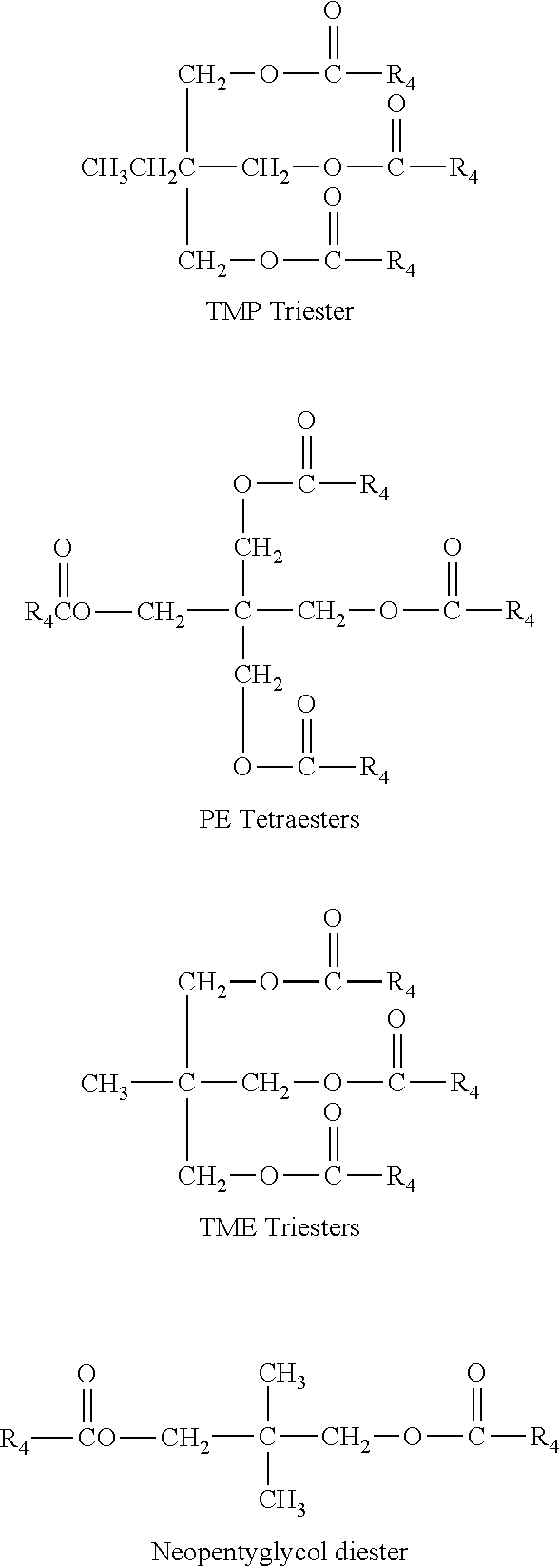Polyol esters of medium chain fatty acids and process for preparation thereof
a technology of polyol esters and fatty acids, which is applied in the preparation of carboxylic compounds, fatty acid chemical modifications, organic chemistry, etc., can solve the problems of poor biodegradability, high environmental toxicity, and oil based lubricants
- Summary
- Abstract
- Description
- Claims
- Application Information
AI Technical Summary
Problems solved by technology
Method used
Image
Examples
example 1
Preparation of Trimethylolpropane Triesters of 10-Undecenoic Acid
[0053]Trimethylolpropane (67 g, 0.5 mole) and 10-undecenoic acid (920 g, 5.0 mole) were charged in a 4-necked reaction flask equipped with stirrer, thermometer, water condenser and a nitrogen purger. The reaction mixture was heated to 190° C. under nitrogen atmosphere in presence of stannous chloride (1.0 g). The esterification was allowed to continue until theoretical amount of water was collected. The crude product was distilled at 143° C. temperature and 3 mm vacuum to remove excess 10-undecenoic acid and passed over basic alumina to remove acidic impurities to yield the product (304 g) with acid value 0.05. The product was evaluated for viscosity, viscosity index (V.I.), pour point, flash point and copper strip corrosion and the data is provided in the following table.
PropertyValueViscosity at 40° C. cSt23.87Viscosity at 100° C. cSt:5.33Viscosity Index214Pour Point (° C.)−36Flash point (° C.)286Copper strip corrosi...
example 2
Preparation of Pentaerythritol Tetra Esters of 10-Undecenoic Acid
[0056]Pentaerythritol (68 g, 0.5 mole) and 10-undecenoic acid (920 g, 5 moles) were charged in a 4-necked reaction flask equipped with stirrer, thermometer, water condenser and a nitrogen purger. The reaction mixture was heated to 190° C. under nitrogen atmosphere in presence of stannous chloride (1.0 g). The esterification was allowed to continue until theoretical amount of water was collected. The crude product was distilled at 142° C. temperature and 2 mm vacuum to remove excess 10-undecenoic acid and passed over basic alumina to remove acidic impurities to yield the product (366.6 g) with acid value 0.17. The product was evaluated for viscosity, viscosity index (V.I.), pour point, flash point and copper strip corrosion and the data is provided in the following table.
PropertyValueViscosity at 40° C. cSt36.17Viscosity at 100° C. cSt:7.31Viscosity Index173Pour Point (° C.)+3Flash point (° C.)296Copper strip corrosion1...
example 3
Preparation of Trimethylolethane Triesters of 10-Undecenoic Acid
[0059]Trimethylolethane (200 g, 1.66 mole) and 10-undecenoic acid (3054 g, 16.6 mole) were charged in a 4-necked reaction flask equipped with stirrer, thermometer, water condenser and a nitrogen purger. The reaction mixture was heated to 190° C. under nitrogen atmosphere in presence of stannous chloride (3.2 g). The esterification was allowed to continue until theoretical amount of water was collected. The crude product was distilled at 144° C. temperature and 3 mm vacuum to remove excess 10-undecenoic acid and passed over basic alumina to remove acidic impurities to yield the product (994.0 g) with acid value 0.11. The product was evaluated for viscosity, viscosity index (V.I.), pour point, flash point and copper strip corrosion and the data is provided in the following table.
PropertyValueViscosity at 40° C. cSt24.49Viscosity at 100° C. cSt:5.51Viscosity Index173Pour Point (° C.)−15Flash point (° C.)296Copper strip cor...
PUM
| Property | Measurement | Unit |
|---|---|---|
| temperature | aaaaa | aaaaa |
| temperature | aaaaa | aaaaa |
| hydroxyl value | aaaaa | aaaaa |
Abstract
Description
Claims
Application Information
 Login to View More
Login to View More - R&D
- Intellectual Property
- Life Sciences
- Materials
- Tech Scout
- Unparalleled Data Quality
- Higher Quality Content
- 60% Fewer Hallucinations
Browse by: Latest US Patents, China's latest patents, Technical Efficacy Thesaurus, Application Domain, Technology Topic, Popular Technical Reports.
© 2025 PatSnap. All rights reserved.Legal|Privacy policy|Modern Slavery Act Transparency Statement|Sitemap|About US| Contact US: help@patsnap.com



